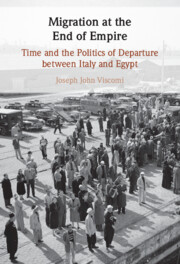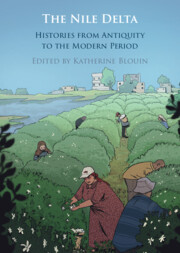259 results
First record of the brachiopod Argyrotheca cuneata from a nearshore habitat at the southern coast of Türkiye
-
- Journal:
- Journal of the Marine Biological Association of the United Kingdom / Volume 104 / 2024
- Published online by Cambridge University Press:
- 26 July 2024, e57
-
- Article
- Export citation
Chapter 1 - The Mediterranean
- from Part I - Zones of Influence
-
-
- Book:
- Europe in British Literature and Culture
- Print publication:
- 13 June 2024, pp 21-38
-
- Chapter
- Export citation
4 - Becoming Refugees, 1954–1960s
-
- Book:
- Migration at the End of Empire
- Published online:
- 30 May 2024
- Print publication:
- 06 June 2024, pp 176-222
-
- Chapter
- Export citation
2 - Isolating Time
-
- Book:
- Migration at the End of Empire
- Published online:
- 30 May 2024
- Print publication:
- 06 June 2024, pp 83-130
-
- Chapter
- Export citation
5 - ‘Leave Us Our Memories!’ Nostalgia, Community, and the Politics of Departure
-
- Book:
- Migration at the End of Empire
- Published online:
- 30 May 2024
- Print publication:
- 06 June 2024, pp 223-262
-
- Chapter
- Export citation
Epilogue
-
- Book:
- Migration at the End of Empire
- Published online:
- 30 May 2024
- Print publication:
- 06 June 2024, pp 263-276
-
- Chapter
- Export citation
Introduction
-
- Book:
- Migration at the End of Empire
- Published online:
- 30 May 2024
- Print publication:
- 06 June 2024, pp 1-32
-
- Chapter
- Export citation
1 - Extraterritoriality and Migrant Diplomacy in Egypt, 1861–1937
-
- Book:
- Migration at the End of Empire
- Published online:
- 30 May 2024
- Print publication:
- 06 June 2024, pp 33-82
-
- Chapter
- Export citation

Migration at the End of Empire
- Time and the Politics of Departure Between Italy and Egypt
-
- Published online:
- 30 May 2024
- Print publication:
- 06 June 2024
‘Palermo is a mosaic’: cosmopolitan rhetoric in the capital of Sicily
-
- Journal:
- Modern Italy , First View
- Published online by Cambridge University Press:
- 23 May 2024, pp. 1-20
-
- Article
-
- You have access
- Open access
- HTML
- Export citation
10 - Crossing the Mediterranean in the Age of Revolutions
-
-
- Book:
- Mobility and Coercion in an Age of Wars and Revolutions
- Published online:
- 09 May 2024
- Print publication:
- 16 May 2024, pp 214-234
-
- Chapter
-
- You have access
- Open access
- HTML
- Export citation
Art and female agency in late Byzantium: three methodological case studies.
-
- Journal:
- Byzantine and Modern Greek Studies / Volume 48 / Issue 1 / April 2024
- Published online by Cambridge University Press:
- 08 March 2024, pp. 100-119
- Print publication:
- April 2024
-
- Article
- Export citation
The influences of temporal-spatial parameters on CPUE of the Atlantic bluefin tuna purse seine fishery in eastern Mediterranean
-
- Journal:
- Journal of the Marine Biological Association of the United Kingdom / Volume 104 / 2024
- Published online by Cambridge University Press:
- 15 February 2024, e6
-
- Article
-
- You have access
- Open access
- HTML
- Export citation

The Nile Delta
- Histories from Antiquity to the Modern Period
-
- Published online:
- 15 February 2024
- Print publication:
- 22 February 2024
Chapter 3 - Food for Thought in Mediterranean Crime Fiction
-
- Book:
- Mediterranean Crime Fiction
- Published online:
- 09 November 2023
- Print publication:
- 23 November 2023, pp 96-119
-
- Chapter
- Export citation
Conclusion
-
- Book:
- Mediterranean Crime Fiction
- Published online:
- 09 November 2023
- Print publication:
- 23 November 2023, pp 202-212
-
- Chapter
- Export citation
Conclusion
-
- Book:
- Mobility Economies in Europe's Borderlands
- Published online:
- 12 October 2023
- Print publication:
- 26 October 2023, pp 168-175
-
- Chapter
- Export citation
3 - Waiting
- from Part I - Libya
-
- Book:
- Mobility Economies in Europe's Borderlands
- Published online:
- 12 October 2023
- Print publication:
- 26 October 2023, pp 83-103
-
- Chapter
- Export citation
Introduction
-
- Book:
- Mobility Economies in Europe's Borderlands
- Published online:
- 12 October 2023
- Print publication:
- 26 October 2023, pp 1-26
-
- Chapter
- Export citation
4 - Turbulence at Sea
-
- Book:
- Mobility Economies in Europe's Borderlands
- Published online:
- 12 October 2023
- Print publication:
- 26 October 2023, pp 104-116
-
- Chapter
- Export citation



